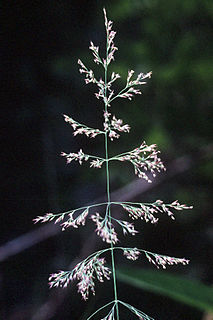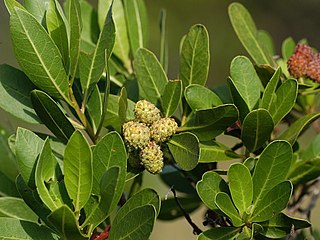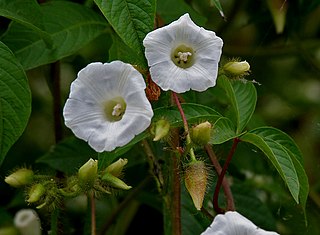
Bauhinia is a large genus of flowering plants in the subfamily Cercidoideae and tribe Bauhinieae, in the large flowering plant family Fabaceae, with a pantropical distribution. The genus was named after the Bauhin brothers Gaspard and Johann, Swiss-French botanists.

Calamagrostis is a genus of flowering plants in the grass family Poaceae, with about 260 species that occur mainly in temperate regions of the globe. Towards equatorial latitudes, species of Calamagrostis generally occur at higher elevations. These tufted perennials usually have hairless narrow leaves. The ligules are usually blunt. The inflorescence forms a panicle. Some may be reed-like.

Aiphanes is a genus of spiny palms which is native to tropical regions of South and Central America and the Caribbean. There are about 26 species in the genus, ranging in size from understorey shrubs with subterranean stems to subcanopy trees as tall as 20 metres (66 ft). Most have pinnately compound leaves ; one species has entire leaves. Stems, leaves and sometimes even the fruit are covered with spines. Plants flower repeatedly over the course of their lifespan and have separate male and female flowers, although these are borne together on the same inflorescence. Although records of pollinators are limited, most species appear to be pollinated by insects. The fruit are eaten by several birds and mammals, including at least two species of amazon parrots.

Bridelia is a plant genus of the family Phyllanthaceae first described as a genus in 1806. It is widespread across Africa, Australia, southern Asia, and various islands of the Indian and Pacific Oceans.

Sterculia is a genus of flowering plants in the mallow family, Malvaceae: subfamily Sterculioideae. Members of the genus are colloquially known as tropical chestnuts. The scientific name is taken from Sterculius of Roman mythology, who was the god of manure; this is in reference to the unpleasant aroma of the flowers of this genus. Sterculia may be monoecious or dioecious, and flowers unisexual or bisexual.

Purshia is a small genus of 5-8 species of flowering plants in the family Rosaceae, native to western North America, where they grow in dry climates from southeast British Columbia in Canada south throughout the western United States to northern Mexico. The classification of Purshia within the Rosaceae has been unclear. The genus was originally placed in the subfamily Rosoideae, but is now placed in subfamily Dryadoideae.

Robert Wight MD FRS FLS was a Scottish surgeon in the East India Company, whose professional career was spent entirely in southern India, where his greatest achievements were in botany – as an economic botanist and leading taxonomist in south India. He contributed to the introduction of American cotton. As a taxonomist he described 110 new genera and 1267 new species of flowering plants. He employed Indian botanical artists to illustrate many plants collected by himself and Indian collectors he trained. Some of these illustrations were published by William Hooker in Britain, but from 1838 he published a series of illustrated works in Madras including the uncoloured, six-volume Icones Plantarum Indiae Orientalis (1838–53) and two hand-coloured, two-volume works, the Illustrations of Indian Botany (1838–50) and Spicilegium Neilgherrense (1845–51). By the time he retired from India in 1853 he had published 2464 illustrations of Indian plants. The standard author abbreviation Wight is used to indicate this person as the author when citing a botanical name.

Colletia is a genus of flowering plants in the family Rhamnaceae, with 5 species of spiny shrubs. All species of this genus are native to southern South America. They are non-legume nitrogen fixers.

Conocarpus is a genus of two species of flowering plants in the family Combretaceae, native to tropical regions of the world. One of the species is a widespread mangrove species, and the other is restricted to a small area around the southern Red Sea coasts, where it grows alongside seasonal rivers.

Osbeckia is a genus of plants in the family Melastomataceae. It was named by Carl Linnaeus for the Swedish explorer and naturalist Pehr Osbeck (1723–1805).

Danthonia is a genus of Eurasian, North African, and American plants in the grass family. Members of this genus are sometimes referred to as oatgrass, but that common name is not restricted to this genus. Other common names include heathgrass and wallaby grass. Australian species have since been reclassified into the genera Austrodanthonia and Rytidosperma.

Helictotrichon, or alpine oatgrass, is a genus of perennial flowering plants in the grass family. The genus name comes from the Greek heliktos meaning twisted, and trichos meaning spine, referring to the shape of the awn.

Setaria is a widespread genus of plants in the grass family.

Seddera is a genus of plants in the bindweed family Convolvulaceae. There are currently 20 known species of the plant. Although it is mainly African, the plant extends to Arabia and India.
Phacelurus is a genus of African and Eurasian plants in the grass family.

Bruguiera is a plant genus in the family Rhizophoraceae. It is a small genus of five mangrove species and three hybrids of the Indian and west Pacific Ocean region, its range extending from East Africa and Madagascar through coastal India, Sri Lanka and Southeast Asia to northern Australia, Melanesia and Polynesia. It is characterised by calyces with 8-16 lanceolate, pointed lobes, 16-32 stamens, explosive release of pollen, and viviparous propagules. It is named in honour of French explorer and biologist Jean Guillaume Bruguière (1750–1798). Recently, the eighth taxa of Bruguiera, B. × dungarra was recognised as occurring in northern Australia.

Merremia is a genus of flowering plants in the morning glory family, Convolvulaceae. Members of the genus are commonly known as woodroses.

Acropora horrida is a species of acroporid coral that was first described by James Dwight Dana in 1846. Found in tropical, shallow reefs in marine environments, it occurs near fringing reefs around turbid water, at depths of 5 to 20 m. It is listed as a vulnerable species on the IUCN Red List, and it is thought to have a decreasing population. It is not common and found over a large area, and is listed under CITES Appendix II.

















